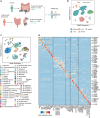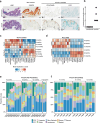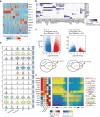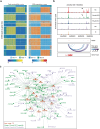Multiomic analysis reveals cellular, transcriptomic and epigenetic changes in intestinal pouches of ulcerative colitis patients
- PMID: 39837850
- PMCID: PMC11751449
- DOI: 10.1038/s41467-025-56212-2
Multiomic analysis reveals cellular, transcriptomic and epigenetic changes in intestinal pouches of ulcerative colitis patients
Abstract
Total proctocolectomy with ileal pouch anal anastomosis is the standard of care for patients with severe ulcerative colitis. We generated a cell-type-resolved transcriptional and epigenetic atlas of ileal pouches using scRNA-seq and scATAC-seq data from paired biopsy samples of the ileal pouch and the ileal segment above the pouch (pre-pouch) from patients (male=4, female=2), and paired biopsies of the terminal ileum and ascending colon from healthy individuals (male=3, female=3) serving as reference. Our study finds an additional population of absorptive and secretory epithelial cells within the pouch but not the pre-pouch. These pouch-specific enterocytes express a subset of colon-specific genes, including CEACAM5 and CD24. However, compared to normal colonocytes, expression of these genes is lower, and these enterocytes also express inflammatory and secretory genes while maintaining expression of some ileal-specific genes. This cell-type-resolved transcriptomic and epigenetic atlas of the ileal pouch establishes a reference for investigating pouch physiology and pathology.
© 2025. The Author(s).
Conflict of interest statement
Competing interests: The authors declare no competing interests.
Figures







Update of
-
Multiomic analysis reveals cellular, transcriptomic and epigenetic changes in intestinal pouches of ulcerative colitis patients.medRxiv [Preprint]. 2025 Jan 9:2023.11.11.23298309. doi: 10.1101/2023.11.11.23298309. medRxiv. 2025. Update in: Nat Commun. 2025 Jan 21;16(1):904. doi: 10.1038/s41467-025-56212-2. PMID: 38014192 Free PMC article. Updated. Preprint.
References
-
- Fazio, V. W. et al. Ileal pouch anal Anastomosis: Analysis of outcome and quality of life in 3707 patients. Ann. Surg.257, 679 (2013). - PubMed
-
- Ettorre, G. M. et al. Mucosal changes in ileal pouches after restorative proctocolectomy for ulcerative and Crohn’s colitis. Dis. Colon Rectum43, 1743–1748 (2000). - PubMed
-
- Hoda, K. M., Collins, J. F., Knigge, K. L. & Deveney, K. E. Predictors of pouchitis after ileal pouch-anal anastomosis: a retrospective review. Dis. Colon Rectum51, 554–560 (2008). - PubMed
MeSH terms
Grants and funding
LinkOut - more resources
Full Text Sources
Medical

